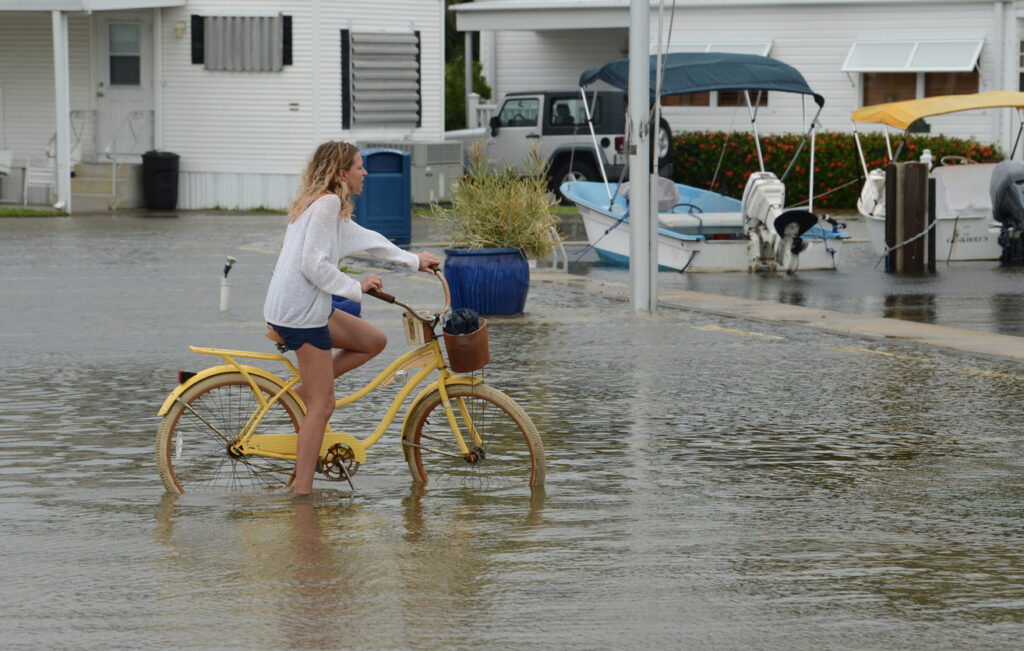By Kimberly Miller, Palm Beach Post
For the first time in its more than 70-year history, South Florida Water Management District officials are looking at direct ties between climate change and shifts in the state’s landscape that will make keeping homes dry and drinking water flowing more difficult in the future.
Fifteen areas vulnerable to harm in a warming world will have baselines set by district scientists to measure against climate change-induced pitfalls to ecosystems and infrastructure.
That includes the obvious, such as sea-level rise and saltwater seeping into wells, but also more subtle concerns such as alterations in alligator sex ratios as temperatures climb.

“We anticipate that these are some of the metrics that will help us determine these impacts, but we recognize the existence of many other influencing factors, especially on water quality aspects,” said district resiliency officer Carolina Maran, about the areas to be examined. “It’s important to mention that there is no final determination that the already observed trends are a result of climate change.”
The effort was reviewed this month in a public workshop, and noteworthy considering Florida is just two years removed from an administration that refused to even use the words climate change.
Gov. Ron DeSantis appointed the current water management district governing board in early 2019 after ousting the previous regime that was considered too friendly to agriculture interests. The board hired Maran – its first resiliency officer – in January 2020.
The district’s initiative is timely with President Joe Biden’s promise for a unified response to climate change and lengthy executive order issued Wednesday with numerous measures aimed at reducing the rate of change and increasing ways to deal with what’s already inevitable. Those include a goal of conserving at least 30% of land and water by 2030, beginning the development of an emissions reduction target, creating the White House Office of Domestic Climate Policy, and establishing the National Climate Task Force.
The district’s launch also coincides with DeSantis’ recently released budget that includes $473 million for Everglades restoration, $25 million to reduce harmful algal blooms, and a pledge of $1 billion over four years to tackle sea-level rise, “intensified storm events,” and flooding.
While South Florida has decades of data on sea level rise with worse-case scenario projections of up to 11 feet of rise by 2120, other climate change indicators have been more haphazardly collected without a cohesive plan in the district to link them with climate change or be viewed in conjunction with each other.
“We have the data, we just want to make it easy for the public to understand and to be able to see the trends,” said Karin Smith, the district’s principal hydrogeologist. “It’s good to see everything pulled together and looked at holistically.”

Smith’s focus in the project is saltwater intrusion into drinking water wells – a slow creep exacerbated by sea-level rise, but also controlled to some extent by managing canals at high enough levels to block the assault.
The district wants to produce a map of where wells have been abandoned because of saltwater intrusion. Smith found 35 in Broward and Palm Beach counties over the past 20 years by searching district permits, including three in Manalapan and seven abandoned by Lake Worth Beach utilities.
She said there’s no danger of drinking water drying up but that saltwater intrusion can mean digging deeper wells into brackish water supplies that are costly to treat.
“You can’t stop sea-level rise, it’s going to push in,” Smith said. “The utilities have to adjust, and they have options, it’s just that some of the options are more expensive.”
Other areas that will be followed for climate change impacts include drought, temperature, water quality, groundwater levels, ecology (such as oyster distribution and seagrass abundance) and rainfall.
An initial study showed a trend from 1914 to 2018 for increasing rainfall in the month of August in a handful of regions, including Palm Beach County and the Treasure Coast. The Treasure Coast saw the same trend when extended to the entire rainy season, but Palm Beach County did not.
Still, that means that scientists can monitor reoccurring rainfall events during those months and help water managers plan for the future.
More rainfall can mean more flooding, especially when the majority of flood control structures in South Florida are gravity driven. A 2019 report by district experts said fixing coastal pumps to make sure they can keep up with sea-level rise could cost $35 million to $70 million each year for a decade.
Where pumps won’t help is on the spongy fringes of the most southern reaches of the state that are losing ground to sea-level rise as plants die and the soil compacts.
Carlos Coronado, lead scientist in the district’s applied sciences bureau, said freshwater plants once dug their roots into soil that bordered Florida Bay to its north.
Now, that area is forests of saltwater-tolerant red mangroves. But even those are likely to die off if salinity levels increase with sea-level rise. Coronado estimates a vast swath of land in southern Everglades National Park will become open water in 20 to 30 years if sea-level rise continues at its current rate.
“Maybe we won’t have the capacity to answer all the questions right away,” Maran said. “We see this effort as a first step in providing water and climate data readily available to the stakeholders in South Florida.”
Kmiller@pbpost.com
@Kmillerweather
“The Invading Sea” is the opinion arm of the Florida Climate Reporting Network, a collaborative of news organizations across the state focusing on the threats posed by the warming climate.



